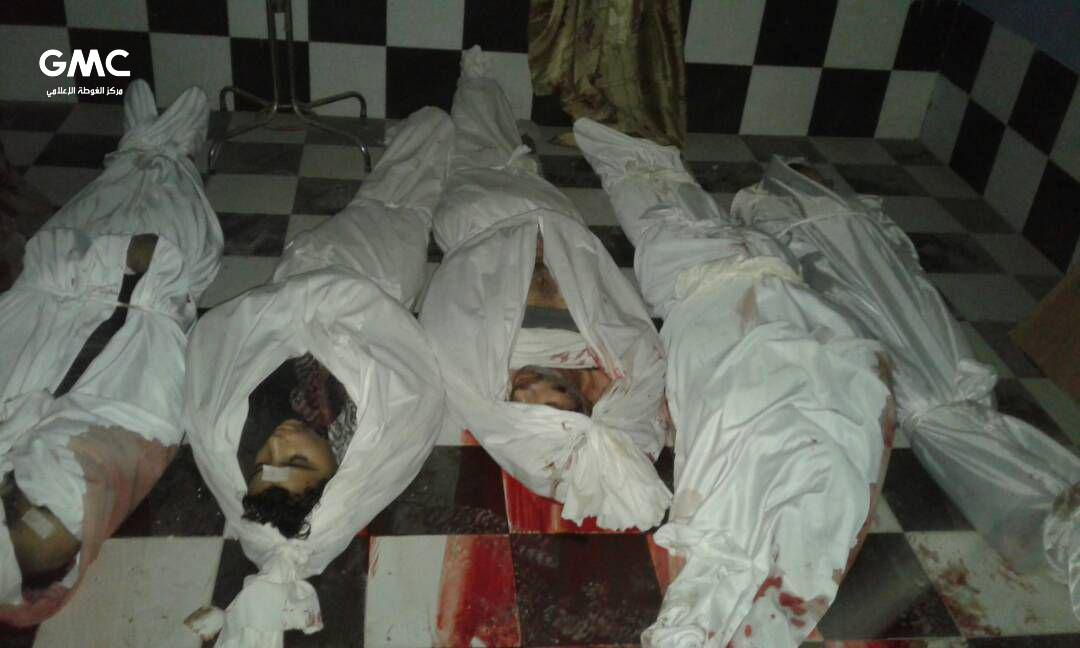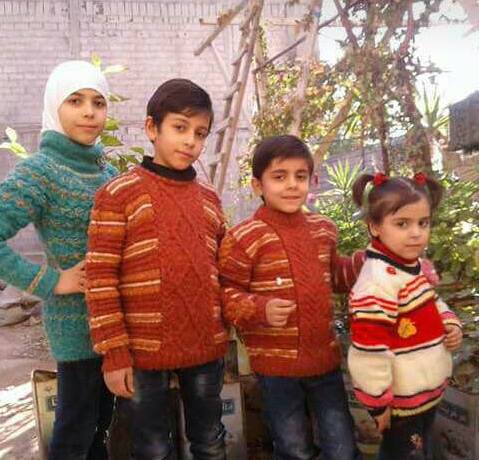Reported Russian airstrikes in eastern Ghouta sharply increased in the last full week of February, allegedly killing hundreds of civilians and reaching levels never before tracked by Airwars researchers.
Syrian government strikes on the rebel-held suburb of Damascus, where 400,000 people remain trapped, had already escalated at the start of February ahead of a possible ground offensive by regime forces. Aid agencies and monitors described the bombings as the worst in years. At a Security Council briefing on February 28th, UN humanitarian chief Mark Lowcock said that over 580 people had been reported killed due to air and ground strikes in eastern Ghouta since February 18th, along with upwards of 1,000 people who had been injured.
That briefing came four days after the Security Council had voted for a ceasefire in the country. What had happened since, asked Lowcock? “More bombing,” he said. “More fighting. More death. More destruction. More maiming of women and children. More hunger. More misery. More, in other words, of the same.days.” Airwars monitoring now indicates that – according to local reports – Russia was likely responsible for a large number of those deaths.
28 airstrikes in only 25 seconds in Qhouta 3 days ago!!.
According to my college @Mahmoudadam87 the civilians still inside the shelters so far, they don’t trust the ceasefire agreement because Assad’s regime forces still bombing #Eastern_Ghouta . pic.twitter.com/e2Fem2S9RL— Khaled Khatib (@995Khaled) February 28, 2018
Hundreds reported killed
Between February 19th and February 25th, Airwars tracked a record 78 new alleged Russian civilian casualty incidents across Syria — almost eight times more than the week prior. All but four of the strikes were reported in eastern Ghouta, where not a single Russian strike allegation was monitored the week before. Two more strikes were reported in Hama governorate, and one each in Aleppo and Idlib governorates.
At least 324 civilians were alleged killed in the 78 strikes, including 59 or more children and 42 women. A further 140 people were reported injured. All but six of the reported deaths were located in Eastern Ghouta. Airwars is still vetting these reports – a task made more difficult because Russia does not release reliable data on where it is bombing – and these numbers should not be directly compared with more fully evaluated civilian casualty figures for the US-led Coalition.
WATCH : This is a basement where 46 families were sheltering from the relentless bombing in #Ghouta #Syria. A 5 hour daily ceasefire is not good enough…https://t.co/mcSkyCxNTl pic.twitter.com/tLu4FGyOak
— SavetheChildren News (@SaveUKNews) February 27, 2018
The reported intensity and toll of Russian and regime strikes suggests an unprecedented onslaught, worse even than the bloodiest periods of the aerial assault on Eastern Aleppo in late 2016.
“This is not the first time Russia joined the regime in bombing Eastern Ghouta,” said Airwars Syria researcher Abdulwahab Tahhan. Two weeks earlier – from February 5th to February 11th – Tahhan’s colleagues tracked 44 civilian casualty incidents allegedly tied to Russia, 24 of which were located in Eastern Ghouta. Then, for roughly a week allegations against Russia fell, only to leap up again, worse than ever.
“It is a pattern we have seen over and over again. Some weeks Russia would open hell on civilians, and some weeks, especially leading up to peace talks, Russia would carry out fewer airstrikes,” said Tahhan.
On February 20th, at least 20 civilians including women and children were reported killed when aircraft fired on Beit Sawa, a town in Eastern Ghouta. The Syrian Network blamed both the regime and Russia, and the Ghouta Media Center posted graphic photographs of corpses wrapped in cloth. Two photographs showed young children who had been killed, their lifeless bodies covered with the dust of debris.

Victims of alleged Russian or regime airstrikes in Beit Sawa. (via Ghouta Media Center)
On the same day, 18 people were reported killed, including 8 women and children, in Arbeen. Distressing photographs showed children wrapped in cloth. Reports cited both the regime and Russia as responsible for bombing in the area.
The following day in Kafar Batna area of Eastern Ghouta, Step News reported that “Russian warplanes and helicopter gunships launched dozens of air strikes” in the vicinity, killing around 20 people, including 7 children.They later raised the number killed to 35, again citing Russian involvement.
Similar reports streamed out. There were, the UN reported, 14 attacks on hospitals, three on health centers and two on ambulances between February 18th and 22nd alone. On that latter date, the Syrian Network reported the deaths of at least 34 people, including seven children and nine women, due to “Syrian/Russian” shelling on Douma in Eastern Ghouta.
On February 23rd, the Syrian Network reported the deaths of four children, Sedra, Samer, Ahmed and Jana Salam, who it said were killed “along with their mother as Syrian/Russian warplanes fired missiles” on the town of Ein Tarma in eastern Ghouta.
On February 24th, local media reported possible Russian involvement in air raids on Douma, east of Damascus, that reportedly claimed the lives of at least 17 civilians. Smart News said the bombings were “likely to be Russia,” while the Syrian Network for Human Rights described the attack – one of several in the area on the 24th – as the work of “Syrian/Russian regime” forces.

Sedra, Samer, Ahmad and Jana Salam. (via the Syrian Network)
‘Devoid of respect for international law’
After days of negotiations and false starts, the Security Council passed Resolution 2401 on February 24th, demanding an immediate country-wide ceasefire. The Council’s wishes were flouted almost immediately, and reported strikes continued in Eastern Ghouta in the hours afterwards. Russian President Vladimir Putin then ordered a daily five hour truce in Ghouta – from 9am to 2pm local time – a step tepidly endorsed by aid officials but called far short of what was needed.
“I have to declare that I know no humanitarian actor, zero humanitarian actor, who thinks the five hours is enough for us to be able to deliver relief into Eastern Ghouta and to organize orderly medical evacuations out,” UN humanitarian adviser Jan Egeland told reporters on March 1st.
“Eastern Ghouta is devoid of respect for international law,” Egeland said amid reports that pro-government forces had begun further ground incursions at the limits of Eastern Ghouta.
Many reports of incidents that cite Russia also name the regime as involved, and it’s not always clear which – or both – took part in a particular strike among potentially dozens in a neighborhood. This dynamic is only more confusing for monitors when it happens in dense urban areas like Eastern Ghouta. “It is not unusual to see local monitors reporting them both,” said Tahhan.
Analysts suggested a number of reasons for the sudden and deadly increase in Russian activity.
“I would attribute the shift to the stabilization of the front in Idlib Province in early February after Turkey deployed observation posts into Eastern Idlib Province,” said Chris Kozak, a senior analyst at the Institute for the Study of War. “Russia started shifting its strike pattern around that time.”
“I’m not sure why they [Russia] ramped up the bombings but one explanation could be that for the past few weeks Russians have been constantly reporting on rebel shelling from Eastern Ghouta including on the Russian embassy,” said Yury Barmin, a Mideast analyst at the Russian International Affairs Council in Moscow. “But I think it’s also indicative of the general dynamic — deescalation zones are unraveling and Russians would like to grab more land if they can.”
“I would imagine that it is linked to Escalation in the north,” said Barmin. “I think they want to move all those rebels from Ghouta to Idlib and secure the capital. The escalation in Idlib was a good excuse to pull this off.”
Afrin casualties continue
Elsewhere in Syria, there was disagreement about whether the Kurdish enclave of Afrin was included in the Security Council ceasefire.
Though a number of key players, including France, Germany and the US insisted that it was covered, Turkey – which launched an invasion of Afrin in January – claimed that it was not.
On March 2nd, the Afrin Health Council raised its estimate of civilians killed by Turkish forces to 207, and said that over 600 people had been reported injured. As Turkish and allied forces steadily encroached from the borders, thousands of civilians who had fled rural areas of the enclave to Afrin city risked falling into greater danger.
Turkey appears determined to face down three major powers (France, Germany and the USA) after
– President Macron insisted the ceasefire “applied to all of Syria, including Afrin"
– The US State Dept urged Ankara to "go back and read" the UNSC resolution https://t.co/ONeRqp4POO— Airwars (@airwars) March 1, 2018
